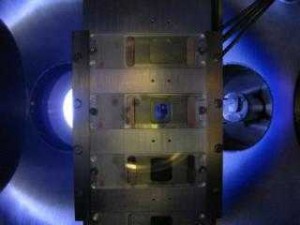A new thin-film technology has been developed that can turn an ordinary window into a power-generating solar cell.

Inside of film-deposition chamber (from Physorg.com)
The Norwegian company EnSol AS, in collaboration with scientists from the University of Leicester Department of Physics and Astronomy in England, are developing a commercial process for large-scale, clean energy production, according to Physorg.com.
“The material has been designed by EnSol AS and is based on nanoparticles that can be synthesized in Leicester, Chris Binns, professor of nanotechnology at the University of Leicester said. “In fact, following some initial investment by the company, the equipment we have here at the University of Leicester is uniquely suited in the world to produce small amounts of the material for prototypes.”
Binns said the film is different from silicon-based solar cells, with the primary advantage that it is transparent and can be applied through standard spray-on techniques. The base material is built at EnSol AS and the nanoparticles are fabricated at Leicester.
Researchers described the film as being “composed of metal nanoparticles embedded in a transparent composite matrix.” The nanoparticles are about 10 nanometers wide.
But the researchers also said the film could be applied to any construction surface and could turn whole buildings into clean power generators.
“The coating would be built into the windows or other materials as part of the manufacturing process,” Binns said. “It could even be used on the roofs of cars to charge up batteries – although powering the vehicles themselves would probably be pushing it.”

A future power source
The film could be coated onto roof tiles to form an interlocking grid of solar cells. Windows coated with the film would only receive a slight tint.
“The basic cell concept has been demonstrated, and it will be the objective of this research and development project to systematically refine this PV (photovoltaic) cell technology to achieve a cell efficiency of 20 percent or greater,” a spokesperson for EnSol AS told Physorg.com.
Prototypes are currently being developed and tested with a goal of commercial manufacture by 2016.
“Photovoltaics are destined to form a key power generating method as part of a low carbon economy and the new technology will bring that a stage closer,” Binns said.
—Don Clyde/Newsdesk
CITATIONS:
New technique announced to turn windows into power generators
Physorg.com, Aug. 10, 2010
New tech opens window of opportunity to harness Sun
The Times of India, Aug. 10, 2010
Transparent Window Film Makes Solar Power A Possibility In Every Home
InverstorSpot, Aug. 10, 2010
New technology that could turn every house window in Britain into a solar panel
Mail Online, Aug. 10, 2010
Pingback: Interesting Reading #554 – 32 iPad wannabes, WiMax2 coming soon, Automatic cars, Alternative P2P Internet and much more… – The Blogs at HowStuffWorks
Pingback: Interesting Reading #554 – 32 iPad wannabes, WiMax2 coming soon, Automatic cars, Alternative P2P Internet and much more… – The Blogs at HowStuffWorks
Imagine when all windows can be laminated with film that convert sun lights into solar energy, in this case, the total surface to collect sun rays will not be limited to the roof top. But i double if this film can have high conversion rate (say >5%) because the direction where the windows is facing will play crucial part.
This sounds like a rip-off of the DSC technology invented by Michael Graezel at École Polytechnique Fédérale de Lausanne (EPFL) in Switzerland in 1988 and developed by Australian listed public company Dyesol. Dyesol is working with both Corus in the UK and Pilkington Glass in USA to turn building products such as steel cladding and glass windows into PV solar cells.
More details here: http://www.sustainable-renewable-guide.com.au